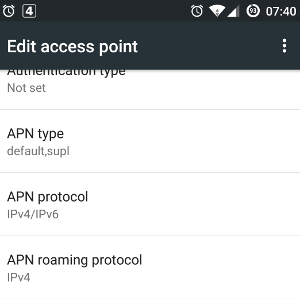I’ve written about having IPv6 access both at home and on my mobile devices anywhere now a number of times before but actually, it’s not as universal as that after all because there is one loophole…
 It’s not quite that universal because IPv6 support currently stops at my home country’s border. As soon as I roam to another country, IP connectivity is limited to IPv4. There are probably several reasons for this. One the one hand I can imagine that not all foreign network operators might be able to handle MAP (Mobile Application Part) messages with information about the use of IPv6 them. In the worst case such messages could just be thrown away and the user would get no connectivity at all. In addition some networks with stone age software in their core might have trouble recognizing PDP context activation request messages from mobile devices that ask for IPv4/IPv6 connectivity. Google seems to have noticed that quite some time ago as the Access Point configuration dialog in Android contains settings to select which IP protocol versions to use in the home network and which to use while roaming. On the left is a screenshot of how that looks like on my smartphone running CyanogenMod. At home, the IP protocol is set to IPv4/IPv6 while the roaming protocol is set to IPv4 only. Even if I set the roaming support to IPv4/IPv6 I still only get an IPv4 address. This means that in the network I’ve tried it’s not yet enabled either. From a technical point of view it’s a bit of a shame but obviously IPv4-only connectivity beats no connectivity at all by light-years.
It’s not quite that universal because IPv6 support currently stops at my home country’s border. As soon as I roam to another country, IP connectivity is limited to IPv4. There are probably several reasons for this. One the one hand I can imagine that not all foreign network operators might be able to handle MAP (Mobile Application Part) messages with information about the use of IPv6 them. In the worst case such messages could just be thrown away and the user would get no connectivity at all. In addition some networks with stone age software in their core might have trouble recognizing PDP context activation request messages from mobile devices that ask for IPv4/IPv6 connectivity. Google seems to have noticed that quite some time ago as the Access Point configuration dialog in Android contains settings to select which IP protocol versions to use in the home network and which to use while roaming. On the left is a screenshot of how that looks like on my smartphone running CyanogenMod. At home, the IP protocol is set to IPv4/IPv6 while the roaming protocol is set to IPv4 only. Even if I set the roaming support to IPv4/IPv6 I still only get an IPv4 address. This means that in the network I’ve tried it’s not yet enabled either. From a technical point of view it’s a bit of a shame but obviously IPv4-only connectivity beats no connectivity at all by light-years.